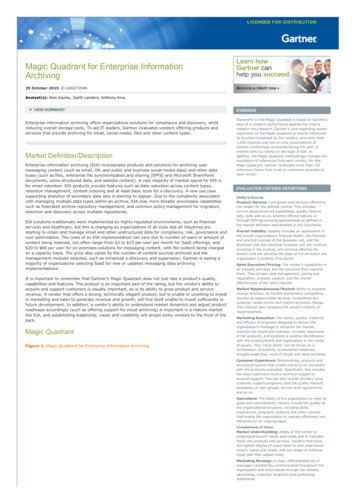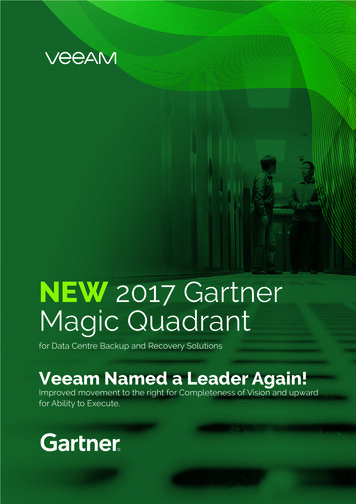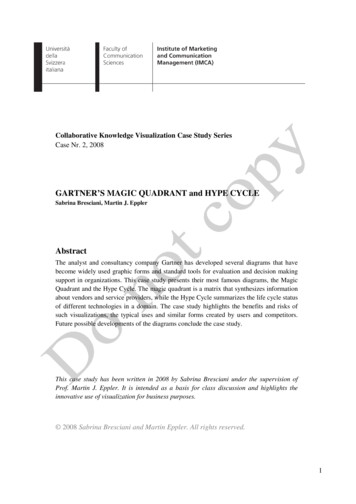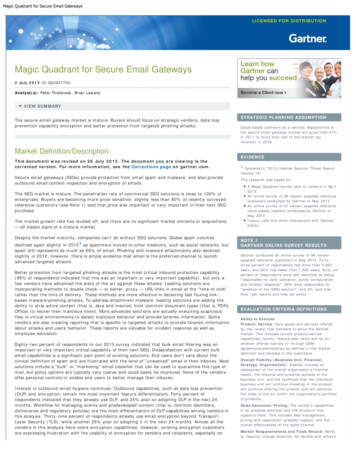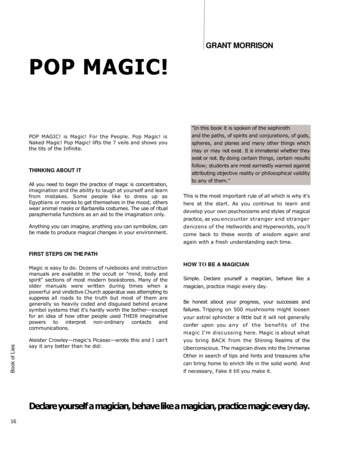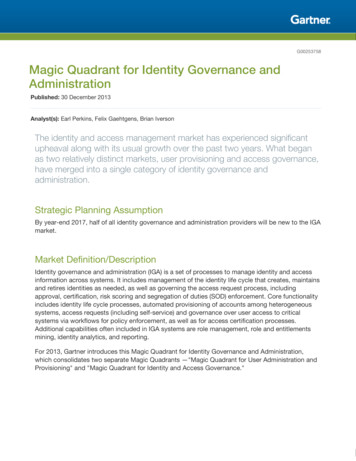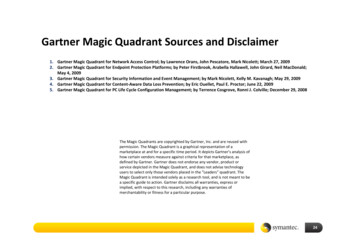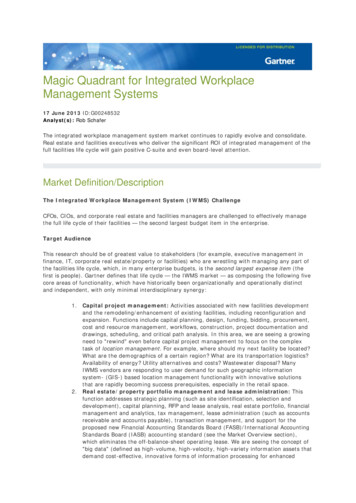
Transcription
Magic Quadrant for Integrated WorkplaceManagement Systems17 June 2013 ID:G00248532Analyst(s): Rob SchaferThe integrated workplace management system market continues to rapidly evolve and consolidate.Real estate and facilities executives who deliver the significant ROI of integrated management of thefull facilities life cycle will gain positive C-suite and even board-level attention.Market Definition/DescriptionThe Integrated Workplace Management System (IWMS) ChallengeCFOs, CIOs, and corporate real estate and facilities managers are challenged to effectively managethe full life cycle of their facilities — the second largest budget item in the enterprise.Target AudienceThis research should be of greatest value to stakeholders (for example, executive management infinance, IT, corporate real estate/property or facilities) who are wrestling with managing any part ofthe facilities life cycle, which, in many enterprise budgets, is the second largest expense item (thefirst is people). Gartner defines that life cycle — the IWMS market — as composing the following fivecore areas of functionality, which have historically been organizationally and operationally distinctand independent, with only minimal interdisciplinary synergy:1.2.Capital project management: Activities associated with new facilities developmentand the remodeling/enhancement of existing facilities, including reconfiguration andexpansion. Functions include capital planning, design, funding, bidding, procurement,cost and resource management, workflows, construction, project documentation anddrawings, scheduling, and critical path analysis. In this area, we are seeing a growingneed to "rewind" even before capital project management to focus on the complextask of location management. For example, where should my next facility be located?What are the demographics of a certain region? What are its transportation logistics?Availability of energy? Utility alternatives and costs? Wastewater disposal? ManyIWMS vendors are responding to user demand for such geographic informationsystem- (GIS-) based location management functionality with innovative solutionsthat are rapidly becoming success prerequisites, especially in the retail space.Real estate/property portfolio management and lease administration: Thisfunction addresses strategic planning (such as site identification, selection anddevelopment), capital planning, RFP and lease analysis, real estate portfolio, financialmanagement and analytics, tax management, lease administration (such as accountsreceivable and accounts payable), transaction management, and support for theproposed new Financial Accounting Standards Board (FASB)/International AccountingStandards Board (IASB) accounting standard (see the Market Overview section),which eliminates the off-balance-sheet operating lease. We are seeing the concept of"big data" (defined as high-volume, high-velocity, high-variety information assets thatdemand cost-effective, innovative forms of information processing for enhanced
3.4.5.insight and decision making) playing a growing role in many corporate real estateoperations, and many IWMS vendors are actively developing robust big data solutionsspecifically tailored for the real estate function.Space and facilities management (FM): This broad area covers functions relatedto the operations and optimization of facilities, and includes facilities planning; spacemanagement; site and employee services management; office hoteling and roomreservations; physical security administration; environmental, health and safety, andmoves, adds and changes; "what if" utilization scenarios; and facilities and spacemanagement analytics. Mobile computing is having a growing impact on the wayIWMSs in general, and space and FM systems specifically, are deployed and utilized.Maintenance management: This function has elements of computerizedmaintenance management systems and enterprise asset management, and consistsof preventive and unplanned/reactive maintenance management, warrantymanagement (compliance and administration), work order administration, parts andinventory management, vendor management, and building assessment.Sustainability/facility optimization and compliance: This is a rapidly growingand evolving function that is focused on the optimization of energy use — a coreIWMS function, since buildings consume as much as 40% of the world's electricity,much of which is inefficiently utilized or even wasted. This area addresses energyefficiency management and reporting (active environmental controls), wastemanagement, recycling, carbon credit calculation, certification and compliance — suchas Leadership in Energy and Environmental Design (LEED) and Building ResearchEstablishment (BRE) Environmental Assessment Method (BREEAM) — and others,such as renewable groundwater supplies, pollution absorption and nonrenewablemineral conservation.The IWMS market is maturing rapidly and is well into its third phase of development: Phase 1 (the 1990s and earlier) was a slow evolution from largely manual systems to theautomation of space planning, facility operations and maintenance. It became the foundationof computer-aided facilities management (CAFM).Phase 2 (the 2000s) saw the proliferation of largely stand-alone CAFM systems andexpanded into broader, more comprehensive functionality (such as lease administration andproject management).Phase 3 is currently characterized by not only a growing wave of first-time IWMS users, butalso the displacement of first-generation and second-generation CAFM/IWMS solutions withmore robust offerings to satisfy much deeper functionality requirements (such as robustsustainability functionality and sophisticated financial analytic disciplines for mature realestate management).Our ongoing research indicates that there are clear benefits and strong stand-alone ROIs to beharvested from deploying single IWMS functional modules. Indeed, we believe the best practice is toavoid the "big bang" approach to IWMS deployment by developing a disciplined, prioritized triage offunctionality — identifying which IWMS functions will have the greatest ROI and deploying themserially, each with its own stand-alone business case.With that said, we believe the real payback and ultimate value of IWMSs is derived from the "I":integration. The effective integration of these disciplines ideally operates from a single database witha common user interface, workflow tools, executive dashboards, and robust predefined andcustomized reporting capabilities.A key IWMS prerequisite to ensuring rapid time to value and consequent ROI realization is robustinteroperability with other enterprise application systems — such as ERP, supply chain managementand human capital management — via increasingly robust Web services technologies.The primary challenge in deploying most IWMSs is candidly evaluating the strengths and weaknessesof existing internal systems and business processes and, where they fall short, adapting them to
those of the chosen IWMS. Indeed, we believe that a core success prerequisite and best practice fordeploying an IWMS is to make the new IWMS the default business process, overriding the currentbusiness process in all but the most compelling cases. In fact, with the robust configurationcapabilities of most IWMSs, this approach can often deliver a long-term "best of both worlds" — arobust, but standardized, easily upgradable system that can be configured to match most of thebusiness's specific requirements.In this context of rapidly evolving IWMS functionality, the following key features have emerged ashigh-demand capabilities (the first three promise the most innovation and high demand withinIWMSs): Mobility: The rapid evolution to an increasingly agile, mobile workforce, along with theincreasing ubiquity of mobile devices (such as smartphones and tablets), is driving users todemand (and vendors to supply) mobile-enabled versions of much of the IWMS productportfolio. Organizations and vendors are quickly seeing the enormous productivity potentialof combining the convenience and power of handheld devices with the robust capabilities ofIWMSs.Robust analytics and big data: A growing number of large organizations are realizing theenormous value that has heretofore been hidden in the vast amounts of real estate datagenerated by most sophisticated IWMSs. When effectively managed and analyzed, the highvolume, high velocity and high variety of the Counselors of Real Estate's (CRE's) big data candrive material competitive advantage and yield significant cost savings in most CREoperations.GIS-based location management: Driven by rapid advances in GIS, organizations nowunderstand the profound impact that GIS-based location management systems can have onthe entire life cycle of a facility — from site selection (for example, site data ondemographics, transportation and energy availability, waste disposal and so on), design andconstruction, to operations, maintenance and enhancement, to ultimate disposition. Indeed,many organizations are demanding — and IWMS vendors are delivering — robust, GISbased functionality that is embedded in many IWMS modules.Reduced time to value: IWMS deployments as recently as three to four years ago hadunacceptably long integration and deployment timelines (as many as 12 to 18 months forcomplex deployments), which were too often unanticipated in terms of time, cost anddedicated resources. While this delay has been largely resolved with many vendors' welldesigned rapid deployment templates, reduced implementation times and quicker ROIsremain hallmark requirements in most IWMS RFPs.Role-based Web portal: Simple Web access is no longer adequate, and most users aredemanding the ability for different roles in the workplace organization to access the systemvia a portal that is tailored to an individual's role in the organization.Facility monitoring and assessment: A growing requirement within many organizations is theneed for comprehensive, accurate, up-to-date data and analysis of building conditions andtrends. Such an intimate and accurate quantification of facility status is a key prerequisite forpredictive analytics and effective capital budgeting of building construction, adaptation,maintenance, and major system replacements or enhancements.Tighter and more effective integration between project management output and real estate,lease, and FM data: Historically, project data would have to be input manually to theproperty database; however, in a properly architected and deployed IWMS solution, this datacan flow automatically from construction to real estate property to FM.Effective interoperability between IWMSs and other enterprise systems: Because mostorganizations run their businesses using major enterprise systems, it has become afundamental requirement for IWMSs to be compatible with the major enterprise financial andHR systems, as well as to operate in multiple database environments (such as Oracle, SQLand DB2). It should be noted that, while such integration with existing enterprise systems isa core requirement, integration with many "homegrown" (or at least heavily modified and/orpoorly documented) systems typically ends up posing the greatest challenge to IWMSdeployments.
Baseline functionality: Once considered to be competitive differentiators, many IWMSfeatures are now regarded as foundational functions with strong customer demand. Theseinclude multiple currency and language translation, worldwide 24/7 help desk support,strong reporting and business intelligence capabilities, and robust analytics and "what if"scenario functionality (for example, lease and financing options, building consolidationvariables, and use assumptions related to office hoteling or desk sharing).Strategic portfolio analysis: Several leading vendors have, in their product road maps,identified the need to provide robust strategic portfolio planning capabilities to include whatif analysis, scenario building, and sophisticated investment and cash-flow analysis —including risk analysis. As mentioned earlier, we believe big data will play an increasinglyimportant supporting role in delivering precise, high-quality IWMS data to enable the mostwell-informed strategic decisions possible.Return to TopMagic QuadrantFigure 1. Magic Quadrant for Integrated Workplace Management Systems
Source: Gartner (June 2013)Return to TopVendor Strengths and CautionsAccruentAccruent was founded in 1995 and was acquired by Vista Equity Partners in 2010. It is currentlyheadquartered in Austin, Texas, and has revenue in the 60 million to 70 million range (Gartnerestimate) that is highly concentrated in North American customers with revenue of less than 1billion. Accruent has become a solidly profitable, high-growth company (it doubled revenue in 2012),largely through rapid-fire acquisitions over the past two years. Its relatively unique strategy amongIWMS vendors focuses on serving specific vertical markets, with distinct, purpose-built IWMS productsuites targeted at specific industries: corporate, retail, higher education and wireless (the first twoaccount for almost 60% of its revenue). Accruent's customer base is trending away from onpremises deployments, and a significant majority of the vendor's revenue is derived frommultitenant software as a service (SaaS).Gartner believes that Accruent and its Vista Equity Partners parent will continue the vendor's aboveaverage growth with more targeted acquisitions (for example, international) through at least 2014.Strengths Customer feedback indicates that Accruent's IWMS suites generally have good functionalmatches in the vertical industries in which they play, which can reduce implementation costsand optimize business value.Since its January 2010 acquisition by Vista Equity Partners, Accruent has grown rapidly ingross revenue and profitability. Its strategy of organic and acquisitive growth has yieldedgood financial stability and improved long-term viability.Since the Vista acquisition, Accruent users indicate that consistency and quality of supporthave improved.Cautions While Accruent's four-suite (going to three with the Famis-360Facility migration; targetcompletion: YE13), industry-specific IWMS approach promises implementation and functionalbenefits, it also comes with the potential risk of higher development, enhancement andsupport costs, and a longer time to market than more unified product suites that may needmore industry-specific tailoring.Although Accruent is making inroads internationally, it still derives more than 90% of itsrevenue from North America. Feedback from its multinational customers indicates that theywould like to see greater international focus and functionality.Accruent's current migration of its Famis platform to 360Facility's SaaS-based architecture(target completion: YE13) poses some potential risk for current and prospective Famis users.Return to TopArchibusHeadquartered in Boston, Archibus was founded by its current CEO, Bruce Kenneth Forbes, in 1982,and is a large, global provider of real estate, infrastructure and FM solutions. It has developed aunique business model that is heavily dependent on its extensive network of Archibus Solution
Centers (ASCs), and on its authorized and certified third-party, value-added software and servicepartners and consultants — its Federated Eco-System — for sales, implementation, product supportand development, and other services.The core of the Archibus Federated Eco-System is its growing network of more than 1,600 businesspartners and ASCs, which provide local, regional, national, and global support and services forArchibus solutions.While Archibus states that this Federated Eco-System generates more than 2.2 billion in revenue, itis important to understand that this figure should not be considered an Archibus revenue figure inthe traditional, audited accounting sense of a public company, but rather a gross representation ofArchibus' extensive ASC and third-party partner Federated Eco-System.Strengths Archibus has a strong international presence (its revenue is about equally divided among thethree major geographies: the Americas, EMEA and Asia/Pacific), and through its FederatedEco-System of partners and ASCs, Archibus' products and services are available in morethan 190 countries and in 30 languages.Archibus offers a full range of integrated IWMS functionality, and is particularly strong in realestate, facility and building operations management, asset management, BuildingInformation Modeling (BIM) 4.0, and environmental sustainability and risk management.Archibus' integrated commercial off-the-shelf structure allows for rapid time-to-valuedeployments (for example, actionable results within 90 days, depending on implementationcomplexity), and is relatively scalable for small, midsize and large organizations.Cautions Archibus' unique delivery model of heavy reliance on its extensive Federated Eco-System ofASCs and authorized/certified Archibus partners makes customers largely dependent on thequality and capabilities of their ASCs and partners. Archibus indicates that it works directlywith the IT and deployment teams at many accounts throughout the world that haverequested its involvement.Some customers indicate that the documentation is overly technical and not targeted at theend user, and that there's room for improvement on Archibus' reporting and printingcapabilities.Customer feedback indicates that Archibus and its partners could better communicate thecontent and ramifications of its upgrades.Return to TopBusiness Integration Group (BIG)Headquartered in Tempe, Arizona, BIG was founded in 1998 and is majority-owned by the large,global, commercial real estate service firm, Cushman & Wakefield. BIG offers a full suite of SaaSbased IWMS functionality and capabilities that covers five key functional "centers": Facility (FM),Portfolio (real estate management), Occupancy (space management), Project and Green(sustainability management).While the majority of BIG's customers are larger organizations (with revenue of more than 5billion), the vendor has good representation (25%) in midsize organizations (with revenue of 1billion to 5 billion) and smaller companies. The great majority (more than 90%) of its deploymentsare via SaaS, and about two-thirds of its business is derived from the financial andtechnology/information service sectors. While BIG's products and services are utilized by clientsglobally, it has derived a steady 70% of its revenue from North America, with EMEA and Asia/Pacificcontributing roughly 20% and 10%, respectively.
Cushman & Wakefield's majority ownership gives BIG a strong financial and operational foundationthat removes any real question of its long-term viability. While many of BIG's sales are sourced fromthis channel, BIG operates independently, and also provides its products and services to other realestate service providers. Customer feedback confirms the basic independence of the two companies,and that there is typically no pressure on BIG customers to employ Cushman & Wakefield's servicesdownstream.Strengths BIG prides itself on the ease with which any of its five core IWMS modules can be deployed— many users testify to implementations of less than six months, depending on complexityand scale.BIG's close relationship with its majority owner, Cushman & Wakefield, ensures financialstability and facilitates new product enhancements that are focused on users' practicalrequirements.Positive customer feedback indicates that BIG almost exclusively uses its own qualified,responsive and knowledgeable people for implementation and support.Cautions We have heard of some concern from a few BIG customers that its relatively rapid growthmay be coming at the expense of consistently strong support from existing customers with adeep and experienced talent pool.Some customer feedback indicates that BIG could be more proactive in communicating itsproduct road map and the timing of upgrades/enhancements.Customers have indicated that, when customization is required, it can take longer thananticipated.Return to TopFM:SystemsRaleigh, North Carolina-based FM:Systems, which was founded in 1984, is coming up on its 30thanniversary. Over that time, it has developed offerings across the IWMS functionality spectrum. Itscore strength lies in more operational capabilities, such as FM, space planning and projectmanagement. About 80% of FM:Systems' revenue (less than 10 million, by Gartner's estimate) isfrom North America, and mostly (about two-thirds) from organizations with less than 5 billion inrevenue. Almost all (more than 90%) of FM:Systems' IWMS deployments are on-premises.Based on Microsoft's .NET platform, FM:Systems' IWMS modules have all been internally developedby its own product team, yielding a truly "integrated" system that can drive faster, less compleximplementations and operations. The FM:Interact platform and related modules can also be linked toBIM models and data to support a wide range of workflows.Strengths FM:Systems has the most consistently positive customer reference feedback of the 11vendors in this Magic Quadrant.Unlike many IWMS vendors whose product portfolios have grown through disparateacquisitions, FM:Systems has developed all its FM:Interact modules in-house for a more"integrated" (the "I" in IWMS) solution across all the IWMS functional areas.Customers indicate that FM:Systems has highly visible and predictable total costs (forexample, all service contracts are fixed price, based on an initial detailed needs analysis andan easily configurable, well-integrated product set).Cautions
A significant majority of FM:Systems' customers are enterprises with less than 5 billion inrevenue, and it has a relatively small (less than 20%) presence outside North America. Withthat said, 2012 saw a number of large, new Global 2000 customers, and FM:Systems isdeveloping a rapidly growing network of international partners/resellers that can providedirect sales and first-tier support throughout EMEA and Asia/Pacific.While FM:Systems' installed base is still overwhelmingly deployed on-premises, it states thatits preferred and fastest-growing deployment method is SaaS.Customer feedback indicates that documentation could be improved (for example, too often,new release documentation has not been completely and thoroughly revised).Return to TopIBM-TririgaIt has been two years since IBM acquired Tririga, and while the near term still has its challenges, webelieve that, over the next two to three years, IBM-Tririga — along with its sister product suite, IBMMaximo (also part of IBM's Cloud & Smarter Infrastructure software group) — will continue to evolveinto a strong, integrated and global IWMS competitor.IBM-Tririga currently delivers a robust suite of IWMS applications on a single technology platformand data repository. Its current customer base remains mostly large organizations (about 85% havemore than 5 billion in revenue), located in North America (more than 85%), that have deployedIBM-Tririga's systems on-premises/behind the firewall (more than 90%).IBM continues to make investments in marketing, sales, services (IBM Global Business Services) anddevelopment (for example, 16-language support) to expand the geographic reach of its IBM-Tririgabased IWMS market — especially in EMEA, Asia/Pacific and Latin America, which brought in about25% of its new 2012 customers.We believe IBM's long-term objective is to consolidate and enhance the facilities, real estate, energyand environmental sustainability functionality of its Maximo and Tririga product suites into a singlesolution. With that said, it is well aware of its customers' reticence to major, disruptive productmigrations, so it will likely evolve the two products over time (three to five years) into a consolidatedsystem via integrators and common development tools (for example, leveraging its 2012 acquisitionof Worklight for mobile application development on its Maximo and Tririga solutions).Strengths IBM has made significant progress in attacking Tririga's historical challenges — that is, thelack of a global presence and a robust SaaS offering. Indeed, IBM's global financial andhuman capital resources are among IBM-Tririga's core long-term strengths.The Tririga acquisition has strengthened IBM's Smarter Buildings initiative by adding solidreal estate, facility and energy management functionality.Customer feedback indicates that IBM has brought rigor and a more structured approach toIBM-Tririga's upgrades and enhancements.Cautions As IBM continues to invest heavily to meet its aggressive global IWMS (IBM-Tririga's)expansion plans, our near-term concern remains IBM's ability to deliver globally consistent,quality implementations and experienced support services over the next 12 to 18 months.Existing customer feedback indicates that pricing and support quality can be issues. Afterspeaking with several current customers, our sense is that IBM's "Bluewash" transitionprocess has raised IBM-Tririga's pricing and introduced pockets of support challenges.1Organizations looking for a cloud solution are cautioned that the overwhelming majority ofIBM-Tririga deployments remain on-premises.
Return to TopIndus SystemsMassachusetts-based Indus Systems was founded in 1987 and currently has more than 100employees. In addition, Indus' more than 100 customers are all based in North America, and almostall have less than 1 billion in revenue. Indus' industry sweet spot is the government sector, fromwhich it derives about 60% of its revenue. Although it is a relatively small, U.S.-based IWMS vendor,Indus' iDrawings platform offers a robust, drawing-centric, Web-based approach to facilitiesinformation systems, application development and CAFM services.Indus' core iDrawings platform is a seamlessly integrated drawings and data architecture thatsupports all functional modules of its flagship iDrawings product. iDrawings is an all-SQL, organicallydeveloped (that is, internally rather than via acquisition), Web-based facility drawings andinformation management and sharing system that allows users to store, share and view facilitydrawings and related information using only an Internet browser. Of its total iDrawings installations,about 80% are deployed via a SaaS model.Strengths A central strength of Indus' iDrawings product portfolio is its support of the "I" (integrated)in IWMS. iDrawings has been entirely "homegrown" (developed internally), and, as such, itcan deliver a more integrated view and a more seamless customer experience across alliDrawings' functional modules.Several customers confirm that iDrawings' relative ease of implementation and use, and itsgood price/performance, are among its strongest assets.Customer feedback indicates that Indus is leveraging its relatively small size to deliverresponsive, "high touch" service from implementation to operations.Cautions With the December 2012 release of its core iDrawings 5.0, Indus introduced the initialversion of its Real Property Management Module. Although it appears to be a solid entry inthe real estate management and lease administration area within IWMS, it is still too early tojudge its effectiveness and customer acceptance.Indus is limited to North America and is mostly focused on small or midsize businesses —those with less than 1 billion in revenue.Return to TopLucernexFounded in 2000, Plano, Texas-based Lucernex is a relatively small (revenue less than 10 million,by Gartner's estimate), but fast-growing, IWMS vendor that is exclusively focused on the retailindustry. Its more than 30 customers are all U.S.-based and deployed in a true cloud-delivered SaaSenvironment hosted by Rackspace's cloud services.Despite its limited resources, Lucernex has had good success across the size spectrum of U.S.retailers, with about half of its customers in the 1 billion to 5 billion revenue range, and theremainder evenly split above and below that range.Strengths We view Lucernex's disciplined and exclusive focus on the retail vertical industry as astrength and a caution. Lucernex has a consistent track record of walking away from any
nonretail opportunities, hewing very closely to its core expertise in retail. In this context,Lucernex has a robust IWMS offering that is highly specialized for the retail industry.Customer feedback indicates that Lucernex's strengths are its deep knowledge of the retailsector, its true cloud-delivered SaaS solution (not just "cloud washed"), its experiencedsupport staff, its highly configurable user interface, its good price/performance and its rapidtime to value.Cautions Lucernex's lack of any real international presence makes it problematic for many largemultinational corporations, at least in the near term. With that said, it has aggressive plansto expand in North America (Canada and Mexico) in 2013 and Europe and Latin America in2014.As a small, high-growth company, Lucernex's core challenge will be to maintain its currentreputation for high-quality experienced personnel, delivering solid support duringdeployments and ongoing operations.Lucernex does not offer behind-the-firewall, on-premises deployment.Return to TopManhattan SoftwareManhattan Software has its global headquarters in London and its U.S. headquarters near Boston. Its 50 million to 60 million in revenue (Gartner estimate) is split about equally between North Americaand Europe (with approximately 10% from Asia/Pacific); and its roughly 350 customers are splitabout equally between large (more than 5 billion in revenue) and midsize ( 1 billion to 5 billion inrevenue) enterprises (and about 10% comes from organizations with less than 1 billion in revenue— a market of increasing focus for Manhattan). Its delivery model is also evenly split between onpremises and SaaS models, although the trend is
Magic Quadrant for Integrated Workplace Management Systems 17 June 2013 ID:G00248532 Analyst(s): . worldwide 24/7 help desk support, strong reporting and business intelligence capabilities, and robust analytics and "what if" . multitenant software as a service (SaaS). Gartner believes that Accruent and its Vista Equity Partners parent will .
